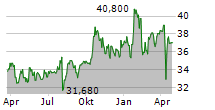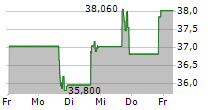NORTHAMPTON, MA / ACCESS Newswire / September 23, 2025 / Patrick O'Connell, CFA | Director-Responsible Investing Portfolio Solutions and Research
Marie Clara Buellingen| Head of Sustainable Finance for the Americas at Societe Generale Corporate and Investment Banking
Blended finance has the potential to transform overlooked markets into investable opportunities.
The United Nations (UN) warns of a roughly US$4 trillion annual shortfall in financing for its sustainable development goals-a gap too large for the public sector to fill alone. Blended finance, which combines public, philanthropic and private capital, can help bridge this divide and unlock progress on global priorities such as poverty reduction, climate action and access to clean energy.
A decade after the UN adopted its 2030 Agenda for Sustainable Development, progress toward many of its goals remains stalled. While some elements of the plan, such as rural electrification, have advanced, insufficient funding has impeded others. Nearly 3.5 billion people live in countries where governments spend more on interest payments than on healthcare or education-leaving little capacity to invest in sustainable development.
At the same time, according to the IMF, global environmental, social and governance (ESG) funds have largely avoided emerging markets. Even though these economies drove the bulk of global GDP growth over the past 10 years, they were allocated only about 6% of global ESG portfolios (Display).
This mismatch highlights a significant untapped opportunity. Blended finance offers a way to gather capital at scale, mobilizing both mainstream investors and those seeking impact. And it charts a path forward: expanding access to underserved markets and growth sectors while offering attractive potential risk-adjusted returns, typically in investment-grade packages.
But first, a quick word on taxonomy.
The Building Blocks of Blended Finance
Blended finance rests on three types of capital: public, philanthropic and private.
Public capital-such as development finance institutions, multilateral banks and government agencies-is usually the first mover. It provides commitments such as guarantees, subsidized loans, anchor investments and policy supports that reduce perceived risk for others.
Philanthropic capital-from foundations, donor funds or high-net-worth individuals-is often used to provide early grants, technical assistance or risk-absorbing funds that bridge gaps and unlock innovation. In some frameworks, it's bundled with concessional forms of public finance under the label "catalytic" or "concessionary" capital. Here, concessional simply means that capital is provided on below-market terms. (In this article, we use "catalytic capital" to mean concessional public or philanthropic funding that accepts below-market economics or first-loss positions to de-risk projects so that private capital can provide the scale.)
Private capital-including institutional investors, banks and corporations-typically comes later, bringing scale and efficiency, along with an expectation of market-level returns. In some schematics, this is called "commercial" or "market-rate" capital.
Each of these buildings blocks plays a distinct role: public capital lays the foundation, philanthropic capital helps further de-risk projects and attract private capital, and private capital drives growth and market depth (Display). Combined in complementary ways, they can mobilize far more resources than any source could on its own.
Growing the Ecosystem: Coordinating Across the Capital Stack
Mobilizing capital at the scale required to close a US$4 trillion gap is no small task. Developing nations must secure financing on manageable terms that can also attract investors-requiring coordination among asset managers, development banks, sovereign governments, rating agencies, philanthropic foundations, insurers and nongovernmental organizations.
Attracting large, durable flows of private capital is especially difficult. Early co-creation among these stakeholders can help produce transparent structures that can be replicated. And catalytic resources brought into the riskiest stages of development can help turn early concepts into viable investment opportunities-building a stronger pipeline for private capital to follow.
A major step toward that kind of coordination came with the inaugural Impact and Blended Finance Conference, held earlier this year. Co-hosted by AllianceBernstein, Societe Generale and the Emerging Markets Investors Alliance, the event brought together stakeholders from across the capital stack and served as a model of buy- and sell-side partnership.
Growing the Ecosystem: Creating a Repository
At the conference, Boston Consulting Group and Societe Generale proposed creating a centralized repository to support blended-finance transactions. By aggregating data on funding availability by region, sector and instrument type, such a resource could streamline dealmaking, reduce transaction costs and increase transparency.
A centralized repository could be a major catalyst for expanding blended finance, helping investors deploy capital more efficiently and at greater scale. It could also make catalytic funding easier to access by reducing variability in eligibility, application and reporting requirements that too often slows projects down.
Growing the Ecosystem: Measuring Success
Scaling blended finance requires clear and consistent measures of success. Investors need to understand both the financial outcomes and the environmental or social impact of each transaction. Developing a common set of standards facilitates reliability and comparability. Such a rigorous approach helps reduce the risk of greenwashing-ensuring that capital is flowing to projects with demonstrable impact while also meeting investor economics. Over time, this kind of transparency builds confidence and encourages more investors to participate.
While stronger coordination, a centralized repository and clearer impact metrics are essential for scaling blended finance tomorrow, investors can already find tangible structures they can put capital into today.
Novel Tools for Sustainable Investment
Among the most visible applications of blended finance are innovative bond structures that channel capital directly into sustainability projects. Two examples-debt-for-nature swaps and outcome bonds-show how creative approaches can deliver both measurable impact and competitive returns.
Debt-for-nature swaps allow developing countries to reduce sovereign debt in exchange for investments in conservation. The structures are complex and require coordination among asset managers, multilateral development banks, sovereign governments and conservation organizations. But the benefits are threefold: for countries at risk of default, these arrangements are a cost-effective way of easing debt burdens; proceeds are directed toward critical projects such as protecting rainforests or safeguarding endangered species; and investors may purchase the bonds at attractive valuations.
One recent debt-for-nature swap not only helped conserve 60,000 square kilometers of Ecuadorian marine territory but also delivered yields higher than many US corporate bonds with comparable credit ratings.
Outcome bonds, like debt-for-nature swaps, fund sustainable development but often with more clearly defined goals. These bonds typically appeal to investors focused on a specific theme, such as restoring the population of black rhinos or reforesting the Amazon.
In some cases, coupon payments are adjusted based on project results-providing investors with both measurable impact and principal protection when issued or guaranteed by a highly rated development institution such as the World Bank.
Historically, outcome bonds have had higher yields than other assets of similar credit quality, and their impact is quantifiable: investors know precisely how many trees were planted, how much carbon was sequestered, or how may rhinos were conserved.
Turning Potential into Outcomes
For blended finance to achieve its promise, it must deliver both measurable impact and returns attractive enough to draw mainstream investors.
Catalytic capital plays a critical role in unlocking larger flows of private investment. When catalytic resources de-risk transactions, sustainability-linked instruments can advance global development priorities while also offering compelling returns to investors.
The challenge is vast, but so is the opportunity: blended finance gives investors a chance to participate at the start of a market poised for major growth.
The views expressed herein do not constitute research, investment advice or trade recommendations, do not necessarily represent the views of all AB portfolio-management teams and are subject to change over time.
Learn more about AB's approach to responsibility here.

View additional multimedia and more ESG storytelling from AllianceBernstein on 3blmedia.com.
Contact Info:
Spokesperson: AllianceBernstein
Website: https://www.3blmedia.com/profiles/alliancebernstein
Email: info@3blmedia.com
SOURCE: AllianceBernstein
View the original press release on ACCESS Newswire:
https://www.accessnewswire.com/newsroom/en/banking-and-financial-services/alliancebernstein-blended-finance-bridging-the-sustainability-fundin-1077196


